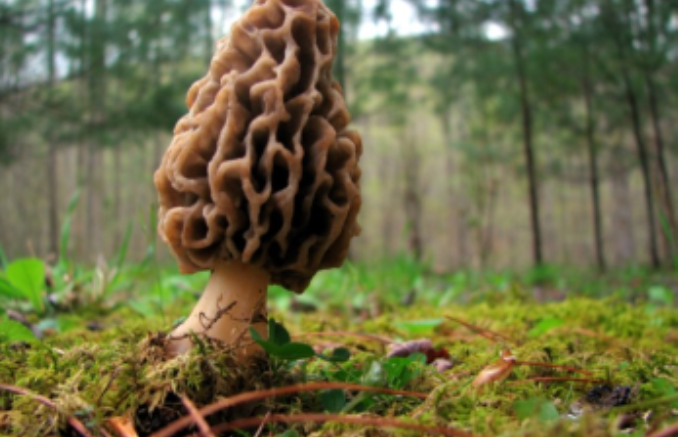A healthy morel mushroom growing in a conifer forest in NW Montana. Photo Courtesy of Ashley South, The Montanian
By Brian Baxter
The burned trunks of the trees from last years fires stand stoically like soldiers on guard duty. Intensely burned soil and duff layers are the blanket below them, seemingly there to put the dead soldiers into eternal sleep. It is a testament to the incredible heat. Upslope, the mule deer wander down the hill, occasionally accompanied by a few scattered elk. They too seek the fruit of a fungus that sprouts in burned over forest soils. More of a truffle than a mushroom, the morchella, or true morel is a delicious treat to both man and beast alike.
The most common are the black and yellow morels. They have a stem with a conical body that is covered with a series of ridges and pits in a kind of honey comb like fashion. Like any natural feature or species of tree or plant, it takes a little time and practice to zone in and identify the exact species, but once a person has the knack, they are spotted and identified quickly. They usually grow in small clumps or groups, which makes woods harvesting productive if the crop is good. In northwest Montana, they usually appear in late April and May in stands of burned over timber from the previous year, sometimes the second year as well. The smart true morel hunter, like the smart elk hunter, keeps his locations to himself, unless of course he or she wants to share with friends or family.
A word of caution must be interjected here, as the closely related false morels can be deadly poisonous when eaten raw. False morels have a cap that appears more wavy and lobed. The true morel has a more uniformly shaped cap that is usually longer than the stem. The cap on the false morel is irregular and appears kind of squashed. Though the cap of the true morel is attached directly to the stem, false morel caps hang freely off the stem. Also, the inside stem of a true morel is hollow, while the stem of a false morel is filled with fibers and chunks of tissue. If you are not sure, get the help of someone who can clearly identify morels. It can be tricky. Some of you woods folks that have been around Kootenai country since the 1970’s may remember a mycologist who ingested the wrong species of fungus and passed away. Always err on the side of caution.
When harvesting true morels, don’t cut the stem too close to the ground, leave a little collar so that the mushroom might reproduce. Do not pack in paper, as it dries the mushrooms, but instead bag in plastic. Once home, empty from your pack and rinse, and then store in fridge with the bag slightly open until you are ready to pack, process, or enjoy. Simply frying and then adding a little butter is a common Big Sky treat.
On the Kootenai National Forest, permitted sites include the 2018 Tenmile fire near Eureka; the 2018 Davis fire near Northwest Peak in the Yaak; and the 2018 Gold Hill fire near Libby. Personal use permits of a total permit value of 20.00 dollars and a 50 lb quantity can be obtained from the Libby Supervisors office at 31374 Highway 2 in Libby, Montana.

